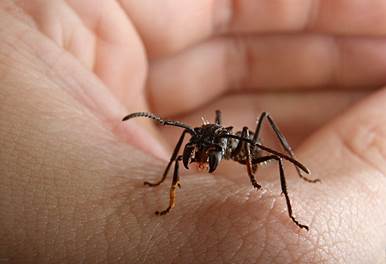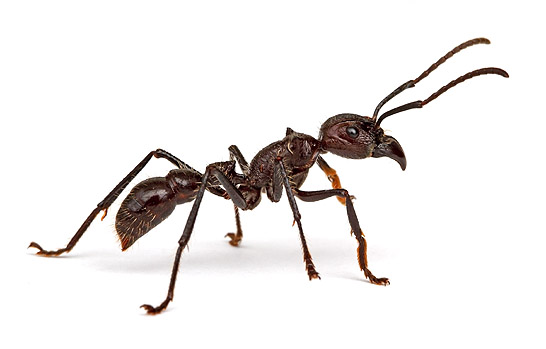The rain forest was not a garden of easy abundance, but precisely the opposite. Its quiet, shaded halls of leafy opulence were not a sanctuary, but rather the greatest natural battlefield anywhere on the planet, hosting an unremitting and remorseless fight for survival that occupied every single one of its inhabitants, every minute of every day. –David Grann, The Lost City of Z: A Tale of Deadly Obsession in the Amazon.
This is a large ant, about an inch long, that lives in the Central and South American rainforest that gets its name from the intense shot of pain delivered by its bite. It has a very strong venom that is quite agonizing. Luckily the pain only last for 12 – 24 hours. It also is known as the 24-hour ant for the duration of pain from a bite.
The bullet ant has a wide distribution throughout lowland tropical forests of Central and South America from Honduras in the north to Brazil and Bolivia in the south. This is an unusually large distribution range for a single species of ant. They are the only remaining species of the genusParaponera, near-ponera, Latinized form of the Ancient Greek ponira (wicked, wretched); clavata– club-shaped.
Its bite sits atop the Schmidt Pain Index, which was developed by Dr. Justin Schmidt of the Southwestern Biological Institute in Arizona. The list:
Level 4: bullet ant, tarantula hawk wasp
Level 3: paper wasp, harvester ant
Level 2: honey bee, yellow jacket, bald-faced hornet
Level 1: fire ant, sweat bee
Now just how many times you need to get bit by one of these critters to make a scientific comparison – I just don’t want to know. The venom is a neurotoxin, which blocks the central nervous system in arthropods and causes extreme pain in mammals. Dr. Schmidt’s description of the bullet ant bite: Pure, intense, brilliant pain. Like walking over flaming charcoal with a three inch nail embedded in your heel. I think that’s about all we need to know to classify them as something to avoid.

Their nest has one entrance and consists of about 40 tunnels and chambers from 3 to 24 inches wide. Rooms at the end of tunnels are for brood chambers where larvae are hatched. A colony contains hundreds of ants and is often found in the soil near a large tree. Workers will leave the nest on foraging expeditions seeking nectar, honeydew, sap, and water and return with the prize clasped in their mandibles. Workers make up the largest percentage of the colony while smaller ants remain inside as nursemaids. Queens are not much larger than workers and are single-mated in established colonies while new colonies are started by lone queens.
Apparently these ants have quite a sophisticated society and often have “ant jails” where adult police ants force juveniles to learn proper ant etiquette. Future workers must learn the proper technique for carrying the delicate liquid food items over long distances while not breaking the surface tension.
The Satere-Mawe people of Brazil use bullet ants as part of a coming-of-age ceremony for young boys. The initiation uses bullet ants woven into a glove of leaves so their stingers face inward, then the boys will put on the gloves for 10 minutes. The ants are anesthetized in a brew of special plants so they can be handled to weave into the gloves, but then they get quite perky once they awake and find they are stuck in the weaving. Some minor protection is offered by charcoal on the hands. When the ceremony is over, part of the arm may be temporarily paralyzed or shake for a few days. The initiation is completed after a tribal member participates in up to 20 sessions of the rite over several months to a couple years.
I came across these critters while hiking in the Bolivian Amazon Basin. Our native guide pointed it out and picked up a stick to herd it around a bit. He explained its powerful sting and then just squatted down tapping the ant gently with the twig and shaking his head slowly side-to-side, murmuring, oh, si, es malo, si, muy mala” (oh yes, it’s bad; very bad).
I had shoes on while on the trail but back in camp I would change into tevas and you can bet I watched where I put my feet.
